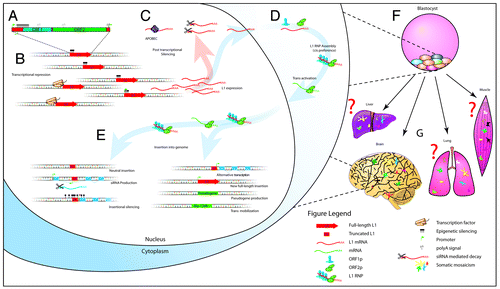Figures & data
Figure 1. L1 is the main driver of retrotransposition in human cells. (A) L1 structure. ORF1 encodes an RNA-packaging protein and ORF2 encodes a protein (ORF2p) with endonuclease and reverse transcriptase domains.Citation50,Citation51 (B) Expression of L1 is limited by transcriptional repression and (C) post transcriptional regulation. (D) L1 ORF1p and ORF2p form an RNP with a marked cis preference,Citation9 but ORF2p can also mobilize other RNAs with a polyA tail in trans. (E) Diverse effects of L1 insertional mutagenesis on gene expression. (F) L1 is known to be highly active during embryogenesis, and in neural cells (G), resulting in somatic mosaicism. Somatic retrotransposition in other adult tissues may also occur.
